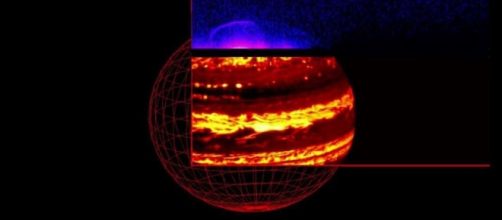juno spacecraft sent the first images of Jupiter´s North Pole, showing weather phenomena and storm systems. The spacecraft completed the first of 36 orbits around the gas giant planet. On august 27, 2916, the space vehicle flew to nearly 4,200 km--- -82,500 miles) above the planets top clouds of gas, during which a great amount of data from the planet was collected. Scientists are still analyzing these data collected; however, some new and innovative discoveries have been revealed.
Jupiter´s Poles
During the first flyby of the gas giant planet, JunoCam revealed that the features that characterize other gas planets are not shared by Jupiter, as the surface features of this part of the planet showed a bluish color that is of a higher hue than other parts of the planet, as well as a number of storms.
The first analysis of this pics showed that the North Pole does not have any latitudinal bands and radiation belts. This first findings suggest that the surface features of the gas giant planet are unique in the solar system.
Science instruments
The instrumentation of the spacecraft was turned on hours before approach. All of its eight Juno´s science instruments were turned off and started collecting data. The Jovian Infrared Aurora Mapper (JIRAM) took the first infrared close-ups of Jupiter´s north and south poles, revealing heated regions that had never been observed before. The southern aurora showed to be a brilliant and well-structured region. It´s expected that the high resolution images of these regions will reveal their dynamics and morphology.
The radio emissions emanating from Jupiter’s surface had been detected before but they had never been recorded with such a great detail. Now scientists will be able to take a closer look at the weak transmissions. These emissions are thought to be the source of energetic particles that create the auroras on the north and South Pole of the gas giant planet. Scientist’s next task is to discover the sources of energy creating them.
Mission
NASA¨s Juno spacecraft was launched on August 5, 2011 and arrived on Jupiter on July 4, 2016. It’s expected that this mission will help disclose the real structure and evolution of Jupiter. This will enable scientists to discover the real formation of the planet and other similar planets in the universe. This will expand our general knowledge of the solar system and beyond.

